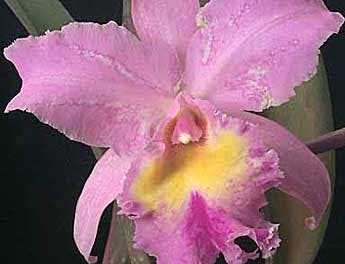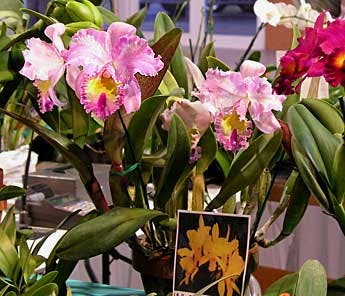
Viruses


Gallery



Symptoms
The symptoms that are caused by viruses are variable and difficult to pinpoint. Sometimes, infected plants are asymptomatic, but still experience a reduction in vigor. Common symptoms on leaves of most orchid genera are irregular chlorotic or necrotic lesions of various sizes. Yellow stripes may also occur. Circular ringspots, yellow to red lesions, with or without necrotic centers, can be observed in some hybrids. Laelia plants tend to exhibit purplish blotches on their leaves. Symptoms on Cymbidium are often mosaic with or without necrosis. Less common but observed in Phalaenopsis is the downward leaf curling. Flowers, mainly those of Cattleya and Phalaenopsis, often exhibit necrosis or color break (variations in the color of the petals). Cymbidium flowers rarely display viral symptoms.
Because of the large variability in symptoms and the possibility of infected plants’ being asymptomatic, identifying orchid viruses is not an easy task. Symptoms may vary according to the plant genotype (genus, species, variety), environmental conditions (temperature, humidity), management of the plants (level of nutrition, stress, etc.), as well as virus species and isolates. In addition, some of the symptoms associated with viruses can be also caused by other factors. For instance, flower necrosis can be caused by CyMV and by fungi such as Botrytis cinerea. In Cattleya plants, flower color break can be caused by ORSV or by drastic changes in temperature, and ORSV-infected Cymbidium can exhibit a mild mosaic that resembles nutrient deficiency.
Treatment
At the present time, there are no proven methods for removing virus from adult plants. In some cases, it has been shown to be possible to produce virus-free mericlones in the laboratory. Infected plants should, at a minimum, be completely isolated from other plants in your collection or, better yet, destroyed.
Prevention
Preventing virus in orchids involves control of insect vectors known to transmit them and to practice excellent hygiene. Hands and cutting tools contaminated from an infected plant are the most common means of transmission. In the same way that human viruses can be spread by touch, so can orchid viruses. Use gloves when repotting, disposable newsprint that can be thrown away between each plant and careful sterilization (by flaming) of cutting tools.
Additional Information
By Juliana Freitas-Astúa
Some 30 different viruses have been reported infecting orchids in various regions of the world. Of those, Odontoglossum ringspot virus (ORSV) and Cymbidium mosaic virus (CyMV) are considered the most important ones due to their prevalence, worldwide occurrence and the severe symptoms they can induce in several orchid genera, often reducing their vigor, lowering flower quality and leading to economic losses. Mixed infections are quite common, because these viruses have similar biological and epidemiological characteristics and are frequently transmitted together.
Further Reading
Detecting Virus in Orchids (PDF, 141kb)
For orchid virus test kits see...
Agdia
All reuse must contain the following:
Reprinted from the SEPTEMBER 2003 issue of Orchids -- The Bulletin of the American Orchid Society. Copyright American Orchid Society --www.aos.org
Testing Plants
Hence, while symptoms are good indicators of a viral infection, they cannot bring certainty to the diagnosis. Because of that, it is advisable to proceed with additional testing for the identification of the causal agent of a particular symptom. One common method used in laboratories is a serological assay, namely ELISA (Enzyme-linked immunosorbent assay), which uses a specific antiserum to detect a particular virus. This test is sensitive and used often in laboratories around the world. Biological assays, transmission electron microscopy, hybridization and RTPCR, among others, are useful tools that can be used for their detection. Even without known vectors, unlike most other viruses, ORSV and CyMV are the predominant viruses around the world. This can be explained by their stability, high concentrations in infected cells and being spread mainly by contaminated tools during regular manipulation of the plants. Therefore, people working with orchids become their main transmission agents, helping their perpetuation from one plant to another and their dissemination to other plants and production areas.
Controls
It is important to remember that there is no cure for an orchid infected with ORSV or CyMV, even though efforts have been made to produce genetically engineered resistant plants. Thus, the best way to control orchid viruses is by prevention, avoiding their entrance in the growing area. This is not easy to do, particularly when infected plants are asymptomatic. Because of that, one should always buy orchids from certified producers and avoid bringing plants with symptoms home. Special attention should be given to mother plants, which ought to be guaranteed virus-free.
If viruses are already present in the area, several measures need to be taken. Infected plants should be discarded and the suspicious ones should be isolated to prevent further dissemination of the viruses. Separating plants of different ages also helps prevent viral spread, since the older the plant is, the higher its chance of being infected. This occurs because the longer a plant stays in the production area, the more often it has been manipulated, and as it is known, ORSV and CyMV can be transmitted by handling during dividing, repotting, cutting or any other management practice.
Case Study
One example that illustrates this spread well is a study we carried out in Brazil in a Cymbidium production area infected with ORSV. No virus was detected in young plants (less than one year old), only 3.7 percent of intermediate plants (one to two years old) tested positive for the virus, but ORSV was detected in 61.4 percent of the adult plants (two to four years old). These results suggest a significant increase in the virus incidence with the age of the plants, explained by the high frequency of manipulation that these plants go through year after year. Interestingly, mother plants (more than four years old) had low virus incidence (1.1 percent or eight infected in 698 plants tested). This occurred because, in this property, mother plants are kept separated from the production area, and are treated with extra care. The employees responsible for them do not enter the regular production area and disinfect their tools every time they work with a different plant in order to avoid pathogen contamination. This shows that, even though these viruses are easily transmitted, they can be controlled when the proper measures are taken.
It is recommended to work first with younger plants and then older ones. Some basic sanitation practices are: washing hands with soap, using disposable gloves when repotting, sterilizing pots and substrates, disinfecting tools between plants with 10 percent commercial sodium hypocloride, 2 percent sodium hydroxide or 5 percent sodium triphosphate for five minutes, flaming for several seconds (after the tools are dipped in alcohol), or heating with at least 300 F° (132° C) for one hour. Single-edge disposable razor blades can be used for cutting; use each razor on one plant only, then discard the blade. Pots can be soaked in a solution of household bleach (1 cup in a gallon of water [237 ml per 4.5 l]) for at least 30 minutes, dried and reused after a thorough rinsing. Potting substrate should not be reused.
In addition, young plants originated from seeds are more likely to be virus free because seed transmission has not been reported for ORSV or CyMV. It is important to mention, however, that some less-common orchid viruses such as potyviruses can be transmitted by the seeds from an infected plant, it is advisable to determine which virus is infecting it. Another important aspect to be considered is that most viruses, including ORSV and CyMV, are systemic in the plant, being present even in the apparently healthy, asymptomatic tissue. it is known that some viruses can be eliminated from a plant through in-vitro meristem-tip culture. This technique may work for CyMV, but not for ORSV. The latter virus often remains viable in vitro and is multiplied along with the plant tissue, causing even more losses to the grower. However, we have obained good results with the addition of a chemotheraputic compound in vitro, together with meristem-tip culture. (The chemotheraputic compound normally used for the production of ORSV-free plant is ribavirin, which inhibits viral development.) It is important to note, however, that this technique is recommended in only a few particular cases, since it is laborious, time consuming, expensive to perform and does not always produce 100 percent virus-free plants.
Other viruses that affect orchids, such as orchid fleck virus (OFV), cucumber mosaic virus (CMV) and several poty- and tospoviruses, among others, are transmitted by arthropods such as mites, and insects such as aphids and thrips. Although less common in orchids, they can occur and cause damage to the plants. The principles for virus management discussed above are the same for all of them. However, in addition, control the vectors and their alternative hosts — weeds that may grow near the orchids.
Finally, remember that viruses are everywhere, but if we use the right management practices, it is possible to eliminate or reduce viral infection and win the battle against these pathogens.
Juliana Freitas-Astúa, PhD, received her doctorate degree in plant pathology in 2001 at the University of Florida, Gainesville, and then returned to Brazil, to work for EMBRAPA (Brazilian Agricultural Research Corporation), where she continues to study plant viruses. EMBRAPA/ CAPTACSM, Rod. Anhanguera km 158, CP 4, CEP 13490-970, Cordeiropolis, Sao Paulo, Brazil (e-mail jfastua@ centrodecitricultura.br).

FREE ACCESS: Orchid DealWire
Get notified when orchid vendors have special promotions and exclusive savings.







